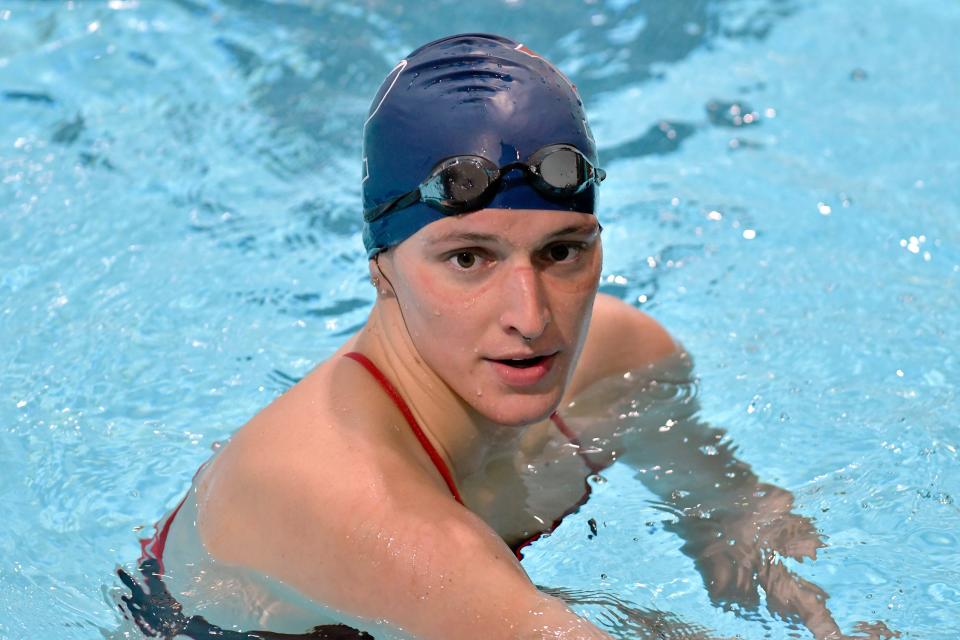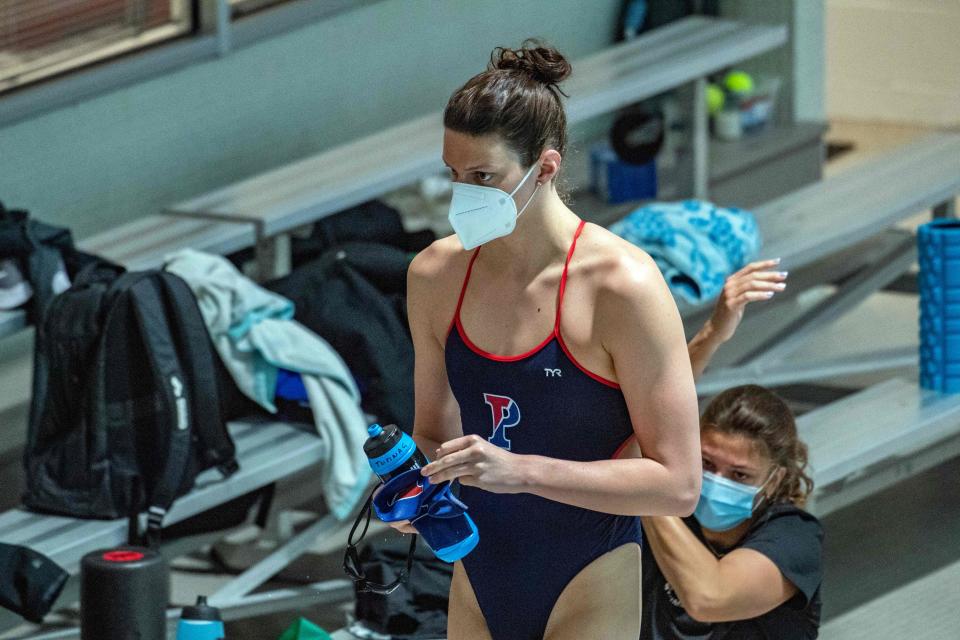Here’s how NCAA’s new ‘ridiculously complex’ transgender guidelines complicate hot-button issue
- Oops!Something went wrong.Please try again later.
If the NCAA were a party in American politics, the governing body of college sports would undoubtedly be considered moderate.
The organization’s redacted guidelines on transgender inclusion in its sports clearly reflect that. Now, that punting approach has generated a major lack of clarity to where both sides of the issue are unsatisfied. This only muddies an already complex issue outside of the competitive arena.
The NCAA Board of Governors voted last week in support of a sport-by-sport approach to transgender athletes’ participation to “preserve opportunity for transgender student-athletes while balancing fairness, inclusion and safety for all who compete.” The most notable adjustment to that policy, effective immediately, is in alignment with recent changes to the U.S. Olympic and International Olympic Committee in monitoring a transgender female athlete’s testosterone levels.
The NCAA was responding to backlash that followed the success of University of Pennsylvania swimmer Lia Thomas, a transgender woman who broke multiple records in a meet last month. Thomas said she began hormone therapy in May 2019, making it unclear what her testosterone counts are.
“After ‘monitoring the situation’ around anti-trans bills and their own calls for more research before even considering updating their very out-of-date language in the 2010 policy, the NCAA whipped up a ridiculously complex policy that will prove impossible for them to follow,” trans Olympic duathlete Chris Mosier, who has been fighting for inclusion of trans rights for over a decade, said in a statement.
The International Olympic Committee adopted its current guidelines in 2015 after Mosier challenged the IOC’s rules for transgender athletes that required gender reassignment surgery.
Here’s a look at what the modified guidelines will mean for all of college sports:
How will these guidelines work and what do they mean?

NCAA transgender athletes who identify as female will now be required to document sport-specific testosterone levels before their championship selections. If the sport doesn’t have a governing body, then athletes apply to the sport’s international federation’s rules. If no federation exists, then they follow the International Olympic policy.
Previously, guidelines of the NCAA required transgender female athletes to have completed one year of testosterone suppression treatment to be able to compete in female sports. But no testosterone counts were regularly checked.
Now there will be three specific check-ins for transgender female athletes, documenting testosterone levels at the start of the season, six months later and then four weeks before their sport’s championship selections.
The NCAA’s attempt is to make rules specific to each sport similar to the Olympics, which saw several transgender athletes compete at the Tokyo Games this past summer for the first time in sports history. The IOC’s guidelines similarly deferred to governing bodies, and that didn’t come without scrutiny. U.S. sprinter Cece Telfer, a transgender woman who won the 2019 NCAA Division II championship in the 400 meters, was ruled ineligible because she did not meet the testosterone level requirements of five nanomoles per liter outlined by World Athletics — the international federation for track and field.
Joanna Harper, a physicist, researcher and visiting fellow for transgender athletic performance at Loughborough University in London, was previously an adviser to the IOC on transgender inclusion. Through her research in the British Journal of Sports Medicine, she has long maintained that an unfair advantage by female transgender athletes can be addressed by scientifically-vetted testosterone monitoring that can be different for each sport.
“Although I applaud the NCAA for deciding that testosterone is an important differentiator between male and female athletes, they do need to iron out the details of their policy before it is complete,” Harper told USA TODAY Sports. “Beyond looking at the details of the NCAA policy, one needs to adopt a bigger picture of testosterone levels and trans women.”
Why are the guidelines so complicated?
The NCAA’s move to adjust its guidelines but defer to individual sports may have intentions of fairness in mind considering how different competitive advantages can range from sport to sport for female transgender athletes. However, the policy comes at a time when the individual sports’ governing bodies that they plan to defer to are in no way ready to handle.
That’s evidenced in some of the NCAA’s biggest sports and in all of its 24 sports across three divisions.
NCAA swimming, for example, requires transgender student-athletes to look to USA Swimming for eligibility criteria. USA Swimming has a policy for transgender athletes that was adopted in 2018 and includes a process where transgender athletes must submit documentation to a review panel. But there’s an additional step it requires for “elite athletes” to face additional regulations from the IOC and FINA, swimming’s international federation based in Switzerland. There is a lack of clarity from FINA on its public domains about its testing and it’s unclear if NCAA athletes would be considered “elite.”
Harper finds the determination process far too convoluted and unclear, noting that even the IOC does not have a scientifically-backed framework finalized or in place yet.
“The new NCAA policy requires transgender women to submit testosterone levels and yet also states that the determination of eligibility rests with sports-governing bodies such as the International Olympic Committee (IOC),” she said. “One cannot reconcile the requirements for testosterone measurements with the 2021 IOC transgender framework, which rejects any restrictions of transgender athletes until robust, peer-reviewed, sport-specific research demonstrates an overwhelming competitive advantage. The NCAA also has not specified a method of enforcing any testosterone limit determined by the relevant sports-governing body.”
Why is there concern the NCAA is punting on this?
The NCAA said in a statement it is acting “steadfast” in its inclusion of transgender athletes. However, critics are pointing out a rushed process that makes it seem as though the organization caved to external pressures following backlash from Thomas’ success. The first set of NCAA guidelines, released in 2011, were developed with varying parties including trans and nonbinary athletes.
It seemed as though the NCAA was building toward a similar vetting approach that would’ve taken more time to allot necessary research considerations. In October 2020, the organization hosted the Gender Identity and Student-Athlete Participation Summit that included current and former student-athletes, doctors, consultants and advocates. Richard Budgett, IOC's medical and scientific director, was one of many there.
Except many LGBTQ advocates have expressed feeling blindsided by the NCAA’s sudden action. They argue that this newly outlined approach removes the opportunity to take a strong stance that would influence society. It instead plays a more reactive approach, while trying to appease several sides.
Human Rights Campaign interim president Joni Madison is most worried about the message being sent to transgender athletes as well as to transgender youth.
“The NCAA’s new policy … is concerning, particularly given that it came as a surprise to advocates who had been engaging with the NCAA on this issue,” Madison said. “Their rollout of this policy has left many athletes and individual sports programs confused, concerned and uncertain about their future. The NCAA’s unresponsiveness, unwillingness to re-implement common sense language, and inability to enforce their own policies to protect athletes’ vulnerable to discrimination are all deeply disappointing and dangerous. We know they are capable of better.”
This punting approach follows the pattern of college sports’ governing body, which often opts to defer more to its university members when it comes to controversial LGBTQ policies.
What happens with Lia Thomas and others?

Although the NCAA’s changes have the potential to exclude Thomas, the adjustments are unlikely to lead to ineligibility for Thomas, who drew national attention for shattering records at the 2021 Zippy Invitational. Thomas competed on the men’s team in 2018-19 and 2019-20 before beginning hormone replacement therapy. Thomas’ 1,650-yard freestyle, in particular, turned heads as it was 38 seconds ahead of the second-place finisher in the December meet.
If USA Swimming and FINA do not release updated policies before the NCAA swimming championships in March, then according to the new NCAA guidelines, the “previously established IOC policy will be used.” That means that hormone therapy would’ve needed to happen at least 12 months in advance, which Thomas qualifies under. She’d still have to have a testosterone level below 10 nmol/L. So long as Thomas is below that threshold, it is expected she will be able to compete.
What is the opposing side saying?
The NCAA’s update hasn’t just upset the transgender community; it’s infuriated many detractors of transgender inclusion.
Nancy Hogshead-Makar is a former Olympic champion in swimming and founder of Champion Women, a non-profit group that provides legal advocacy for girls and women in sports. She wrote an op-ed for Swimming World arguing that there’s “nothing fair about Lia Thomas competing” and suggested Thomas compete for the women’s team but not have her records or times verified. She cited research that shows in select sports cisgender men and cisgender women have advantages in spite of testosterone suppression.
“If fundamentally what you’re doing is trying to affirm your gender and your identity, you don’t need to win,” she told NBC News. “You don’t need to be in a class that is about honoring women’s accomplishments. There’s other ways to be able to participate in sports.”
Harper vehemently disputes the notion that a transgender female is attempting to cheat, based on her research: “Trans women undertake medical transition to become more like cis women, and not for sports. As a result of the desire to become more female-typical and their physician’s prescriptions, more than 90% of all trans women on hormone therapy have testosterone levels within the reference female range. Thus, the vast majority of trans female athletes (probably including Lia Thomas) will have testosterone values well under any reasonable testosterone limit imposed by sports-governing bodies.”
What is the trans community saying?
The NCAA’s guidelines come amid a plethora of legislative attacks on transgender participation in youth and collegiate sports across the U.S. More than thirty states have introduced or passed bills that limit the ability of trans athletes to participate on teams that affirm their gender identity to varying degrees despite the damaging social and psychological impacts that LGBTQ advocates say exclusion can cause for transgender youth. A USA TODAY Sports investigation this past summer found that many of the government officials and bill supporters’ arguments rely on exaggerated examples and specious claims.
The week the updated guidelines were announced, three states (South Dakota, Arizona and Indiana) began to move on legislation that would restrict access to school sports for transgender youth. Since 2020, at least 10 states have put in place similar laws.
Madison, of Human Rights Campaign, worries most about the trickle-down effect and pointed to the past two years as setting a “disastrous example of what happens when the NCAA does nothing meaningful to stand up” for the transgender community.
“The NCAA refusing to take responsibility for ensuring that LGBTQ+ athletes, women and athletes of color have safe, equitable ability to participate in athletics puts schools and conferences in a position and makes it more difficult to enforce fairness amidst an ever-changing patchwork of laws across the country,” Madison said.
“The NCAA has so far proven to be an unreliable ally to LGBTQ athletes across the country who depend upon the organization to protect them from discrimination and now they owe these athletes answers. Their inaction is giving extremist legislators across the country precisely what they want and need to advance a discriminatory agenda targeting LGBTQ and particularly transgender people: their silence, which provides the cover to push radical policies.”
Follow Scott Gleeson on Twitter @ScottMGleeson
This article originally appeared on USA TODAY: NCAA transgender athlete guidelines are ‘ridiculously complex’

